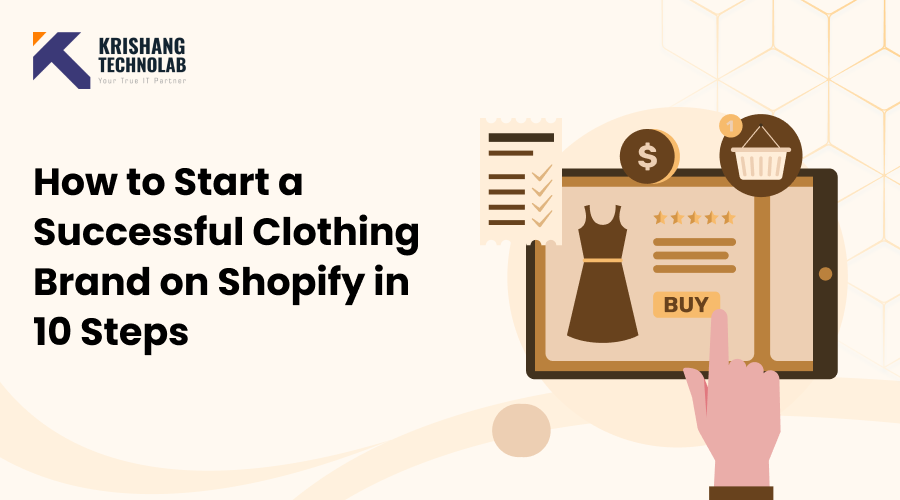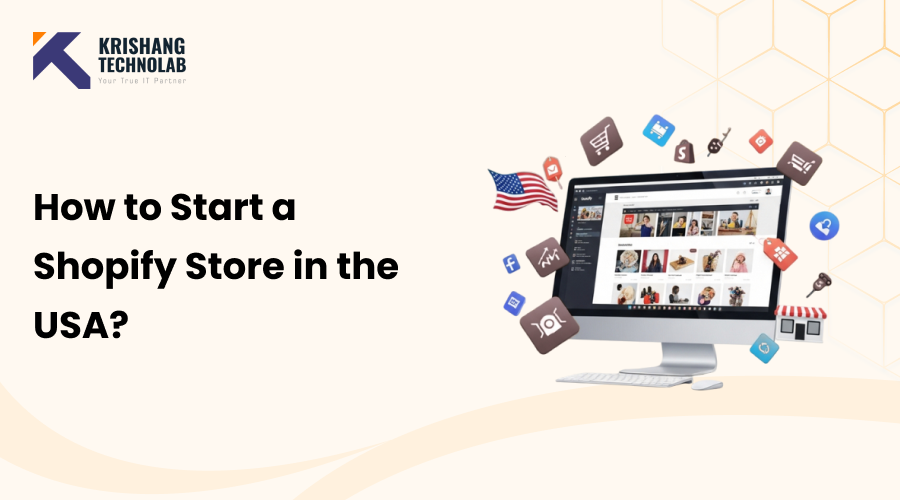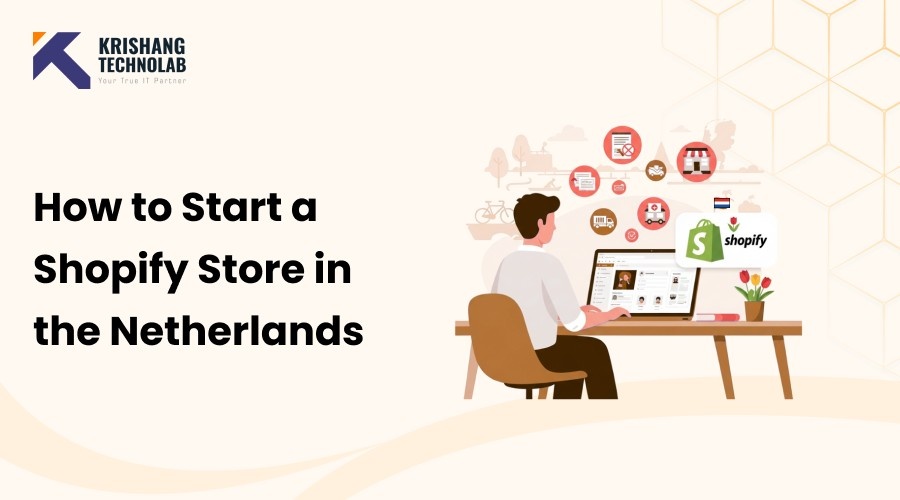Quick Overview: We discuss about how to create a clothes brand with Shopify in this blog. Shopify is one of the greatest places to start and grow an online store. You’ll learn how to establish your brand step by step, from figuring out who you are and what your specialty is to designing products, setting up your Shopify store, and promoting your business well. This guide talks about the benefits of opening an online clothes store, such as inexpensive initial costs, the ability to reach customers all over the world, creative flexibility, and the chance to make a lot of money.
Start clothing brand is now an exciting and easy thing for people who want to be entrepreneurs to do in the digital age. It’s easier than ever to make your idea a reality and reach people all over the world today that e-commerce sites are becoming more popular and people’s purchasing patterns are changing. There are many things you can do, including starting a stylish boutique, making your own clothing line, or starting a lifestyle brand. The sky’s the limit.
Platforms like Shopify have changed the way people start businesses online. Shopify makes it easy to construct a website for a clothes business that looks and works great. The interface is user-friendly, and the features are powerful making it easy to manage, customize, and grow your online clothing business with confidence. Shopify has everything you need to make your ideas a reality, from showing off your products to keeping track of your inventory and running marketing campaigns.
But building a successful online store is more than just making a website. To really stand out, you need to know your brand identity, target demographic, and market niche inside and out, and have a clear plan. This tutorial will help you start online clothes business by giving you useful measures to follow to make sure you succeed.
This guide will help you with every step of the process, whether you want to create a clothes business from scratch, improve an existing brand, or find strategies to open a clothing store. You will learn not only how to create your own online apparel brand, but also how to make it successful by the end of this course. Let’s get started on making your dream of a successful online clothes storecome true!
Benefits of Creating an Online Clothing Business
There are several benefits to start clothing brand, especially in today’s environment where everything is digital first. Here are the main benefits if you want to start a clothes brand from scratch or take your design ideas around the world:
1. Low Startup Costs
You don’t have to pay for rent, utilities, or a lot of personnel as you do at a real store. You don’t need to know a lot about computers or spend a lot of money to create a website for your clothes business. Platforms like Shopify make it easy and cheap to do this.
2. Global Reach & Unlimited Scalability
An internet store can be anywhere in the world. You can reach customers across the globe, 24/7 breaking all the limits of time zones and geography to grow your clothing brand online.
As your personalized clothes brand grows, you can easily grow it by introducing new products, reaching new customers, and improving your marketing.
3. Creative Freedom & Brand Control
You have control over the designs, branding, and messaging when you create your own online clothing brand. You may create a brand that really shows off your style, values, and vision, whether it’s eco-friendly apparel, edgy streetwear, or high-end necessities.
4. Flexible Work Environment
With an online clothes store, you can work from anywhere and set your own hours. You can do all of these things from your laptop or phone: keep track of your inventory, help customers, and execute marketing campaigns.
5. Real-Time Data & Customer Insights
When you sell online, you can see precise analytics. You’ll know which things sell the best, how visitors act, and who your perfect consumers are. These insights assist you make better decisions for your business and improve your strategy all the time.
6. High-Profit Potential
If you have the correct marketing and product approach, an online clothes company can make a lot of money. You can make more money by selling limited editions, bundles, or unique designs that people think are worth more.
7. Easy to Test & Adapt
Online platforms let you swiftly test designs, deals, or marketing campaigns when you’re beginning an online apparel store. You can quickly change based on what works without losing a lot of money or making big promises.
The digital world has more chances than any other place for you to create an online clothes store or transform your design sketches into a genuine business. You can establish a clothing line and make it a well-known name from the comfort of your own home.
10 Steps to Start Clothing Business with Shopify
A strong and unique brand identity is the most important part of every successful clothing business. You need to be very clear about what your brand stands for and how it will stand out in the congested fashion market before you start designing products or developing your store.
Step 1: Define Your Brand Identity
1.1 Your Purpose
Learn what made you desire to start clothing brand. Is it style, niche streetwear, or being good for the environment? Make your long-term goals and mission clear.
1.2 Audience Insight
Find out who you want to talk to. What do they like, what difficulties do they have, and what do they want to know? Make a plan that they can follow.
1.3 Standout Factor
Make sure your unique selling point (USP) is evident, whether it’s affordable costs, eco-friendly fabrics, or personalized designs. Make it something that your customers will want.
1.4 Name & Logo Magic
Create a brand name that is unique, easy to remember, and not already in use. Put a nice logo on your business that genuinely displays who you are.
1.5 Style & Voice
Choose a color scheme and font style that your audience will like and that will help people remember your brand. You can also choose a tone, such as fun, edgy, or luxurious.
Your brand identity should inform all of your decisions. Take your time to build it so that your clothing business stands out and really connects with your clients.
Step 2: Research Your Niche and Target Market
2.1 Identify Your Niche
Pick the part of the clothing business that you want to focus on. Some examples are sustainable fashion, sportswear, streetwear, high-end garments, and infant clothes. Choose a market niche that you love and that is in high demand.
2.2 Analyze Competitors
Look at well-known companies in your niche to see what they do well, what they don’t do well, and where they fit in the market. Look for gaps in the market that your business can fill and ways to stand out.
2.3 Understand Market Trends
Stay up to date with evolving customer preferences, emerging fashion trends, and market shifts to keep your online clothing brand fresh, relevant, and competitive. Use tools like industry journals, social media platforms, and Google Trends to identify potential customers and better understand what your target audience is searching for and engaging with.
2.4 Define Your Target Market
Document detailed insights about your ideal customer, including their preferences, behaviors, and lifestyle, to better tailor your products and marketing strategy. Think about things like where they live, how much money they make, their age, gender, and how they like to shop. If you know more about your target market, you can better address their demands.
2.5 Gather Insights
Use focus groups, surveys, or social media polls to receive direct feedback from potential customers. Using sites like Facebook and Instagram might help you discover more about what your audience likes.
2.6 Validate Your Niche
Use mockups, sample designs, or pre-launch campaigns to get your target audience involved and test your niche ideas. Make sure there is enough demand before you fully commit.
A lot of study makes sure that you are not just entering the field, but also doing it intelligently, which will help your clothing business succeed.
Step 3: Design and Source Your Products
3.1 Select Your Product Range
Choose what kinds of clothes or accessories you will sell. Are you going to focus on T-shirts, hoodies, activewear, kids’ clothes, or a whole collection? Start with a small number of items that fit your brand and specialty.
3.2 Choose a Production Model
- Print-on-Demand (POD): Great for beginners. You make the designs, and someone else prints and ships each order. Low cost up front, but not much room for customization and poor business margins.
- Wholesale: Buy a lot of things from vendors and sell them under your own name. More investment, but more control over prices and inventory.
- Custom Production: Make your own things from scratch by designing and making them. Allows for full customization and originality, but it takes more time and money.
3.3 Focus on Quality
Quality is what makes your brand stand out. If you’re getting blank clothes to print on or working with manufacturers, be sure the materials, stitching, and fit are up to your requirements.
3.4 Maintain Design Consistency
Your product designs should show off your brand’s individuality and appeal to the people you want to buy from. Make sure that the colors, patterns, and logos on all of your products are the same.
3.5 Sample and Test
Always ask for samples before you sell. Check to see if they are comfortable, long-lasting, and appealing to customers. This helps keep people from returning items and makes them trust your brand.
The heart of your business lies in creating and sourcing high-quality, standout products that truly reflect your brand and appeal to your target audience. It’s where your brand comes to life, so take the time to develop it well and get ready for a devoted consumer base.
Step 4: Create a Shopify Account
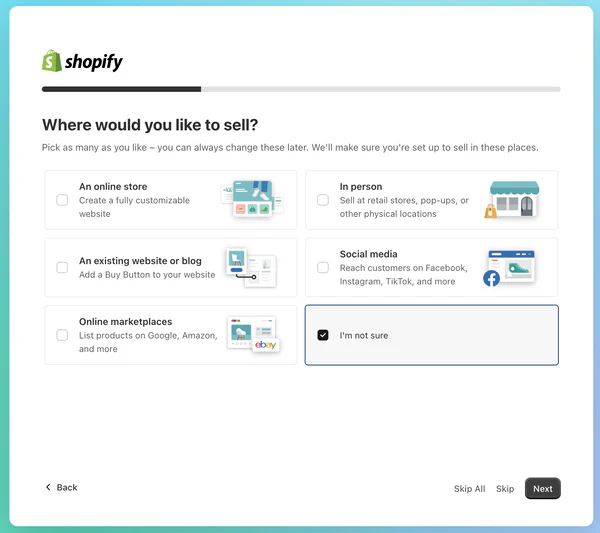
4.1 Sign Up with Shopify
Visit Shopify.com and sign up using your email address. Shopify offers a free trial, allowing you to explore its features and build your store before committing to a paid plan.
4.2 Choose the Right Plan
Pick a plan that works with your budget and the stage of your business. The Basic plan is great for beginning apparel manufacturers. Higher-tier plans come with more advanced features like professional reporting and automation tools. You can make your store better later.
4.3 Pick a Store Name
Your store name should be in line with your brand. It should be easy to remember, related to your niche, and, if possible, match your domain name.
4.4 Register a Domain Name
Using a custom domain gives your website a more professional appearance and helps build trust with potential customers. You can purchase your domain either directly through Shopify or from a third-party registrar, then easily connect it to your store.
The first important step you need to take to start your online store is to get a Shopify account. You should take the time to build up your platform correctly and make sure it reflects your brand from the start. This is where your whole clothes business will dwell.
Step 5: Choose a Theme and Customize Your Store
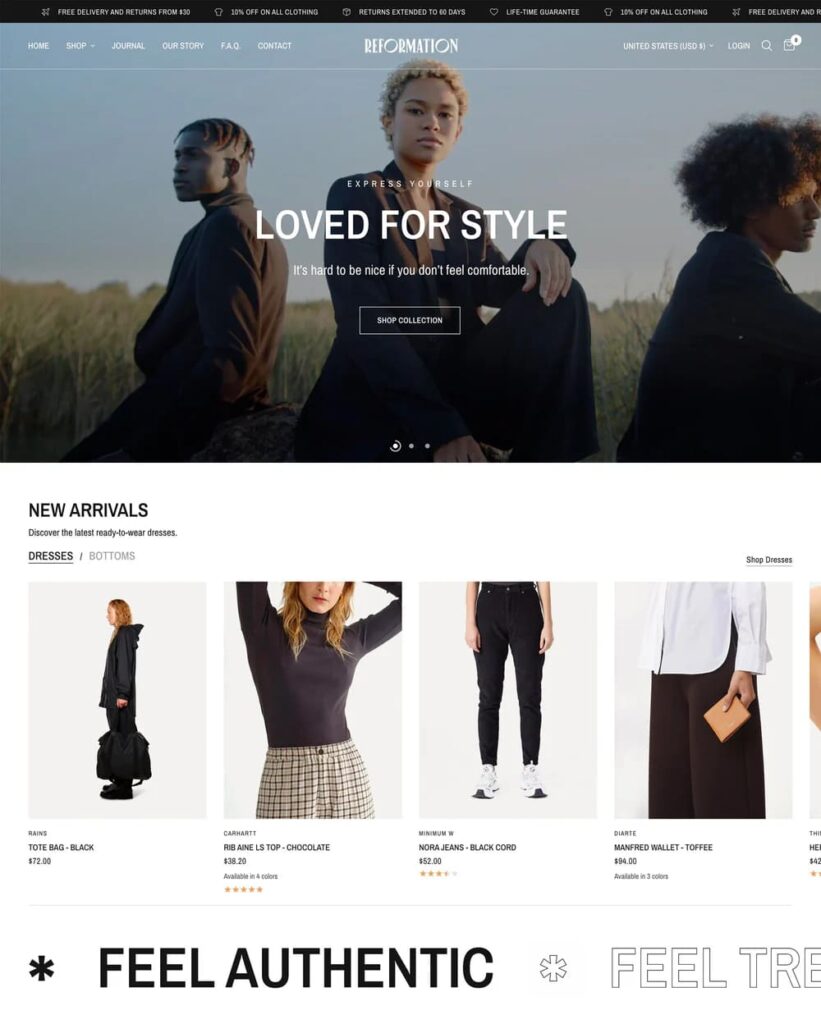
5.1 Pick the Right Shopify Theme
Look through the Shopify Theme Store and pick a theme that matches the look of your business and the type of products you sell. There is a theme for every type of design line, from trendy streetwear to minimalist clothing. Find themes that are mobile-friendly, load quickly, and are made just for fashion or clothing businesses.
5.2 Customize to Reflect Your Brand Identity
After you pick a theme, make it your own. Tailor the colors, typography, and overall layout to align with your brand’s distinct identity and visual appeal. Put your logo on all the pages so that they all seem the same. This helps your viewers get to know you and trust you.
5.3 Optimize Navigation and User Experience
Create a clear, easy-to-navigate menu that helps customers find what they’re looking for quickly and effortlessly. Put your products into groups that make sense, such as “Men,” “Women,” “New Arrivals,” and “Best Sellers.” Make it easy for users to find what they’re looking for by adding a search bar. A pleasant user experience makes people stay on your site longer and increases the number of people who buy something.
5.4 Add Key Pages
Make sure to include pages like About Us, Contact, Size Guide, FAQs, and Shipping & Returns. These articles help establish trust and answer frequent consumer questions before they even inquire.
5.5 Install Essential Apps (Optional)
You could want to add Shopify apps to improve functionality, including reviews, pop-ups with size charts, live chat, or exit-intent offers. Just don’t add too many unneeded features to your store.
The best way to make your brand look how it really is on Shopify is to change the theme. A well-designed store not only makes a good first impression, but it also helps you reach your objective of start an online clothes business in a professional and successful way.
Step 6: Add Products to Store
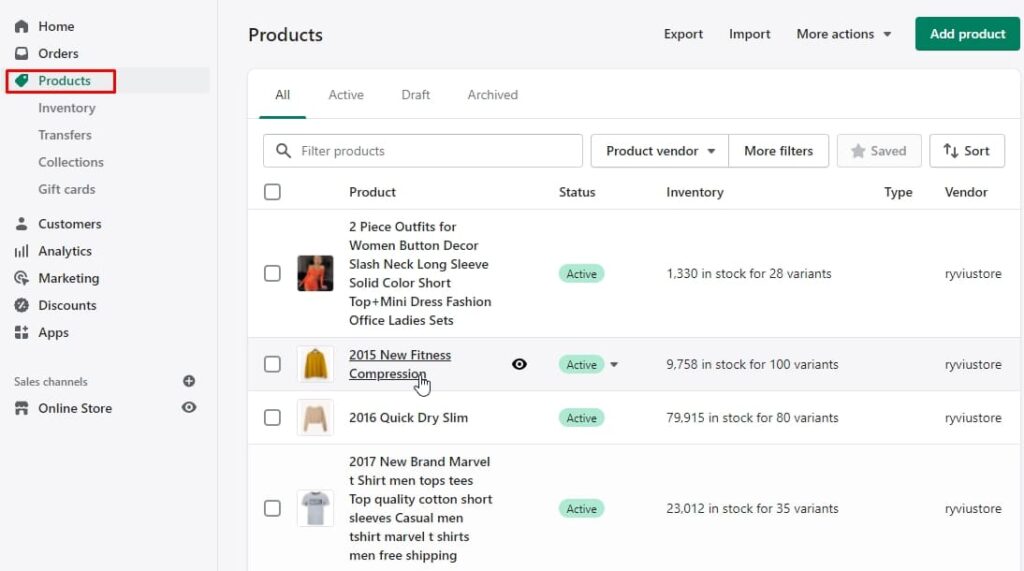
6.1 Write Captivating Product Descriptions
Product stories are communicated by product descriptions. Emphasize the key points such as material, fit, size, and care. Use compelling, descriptive language that connects with your target audience and reinforces your brand’s voice and values. Make it short, benefit-focused, and SEO-friendly to boost search engine rankings and drive online fashion shoppers.
6.2 Upload High-Quality Images
Photos are truthful. Use bright, well-lit, multi-view photos. Include close-up photos of texture, seams, and design details. Show garments on models where feasible to allow customers to view fit and fashion.
6.3 Use Strategic Pricing
Set price according to cost of production, competitors’ prices, and value perceived. Set a profitable price without sacrificing competitiveness. Offer limited-time special discounts or bundle pricing to boost inaugural sales of your new fashion label.
6.4 Manage Inventory Effectively
In your Shopify store, set accurate inventory levels and enable inventory tracking to prevent overselling. For print-on-demand or dropshipping, integrate your supplier for automatic inventory updates.
6.5 Group Products into Sets
Organize products into easy-to-browse categories like “New Arrivals,” “T-Shirts,” “Summer Collection,” or “Best Sellers” to allow for easy navigation and customer direction.
Product descriptions are the backbone of your store. Quality writing, fresh images, and smart categorization will convert browsers to buyers, getting you one step closer tobuilding an online clothing brand.
Step 7: Set Up Payment and Shipping Options
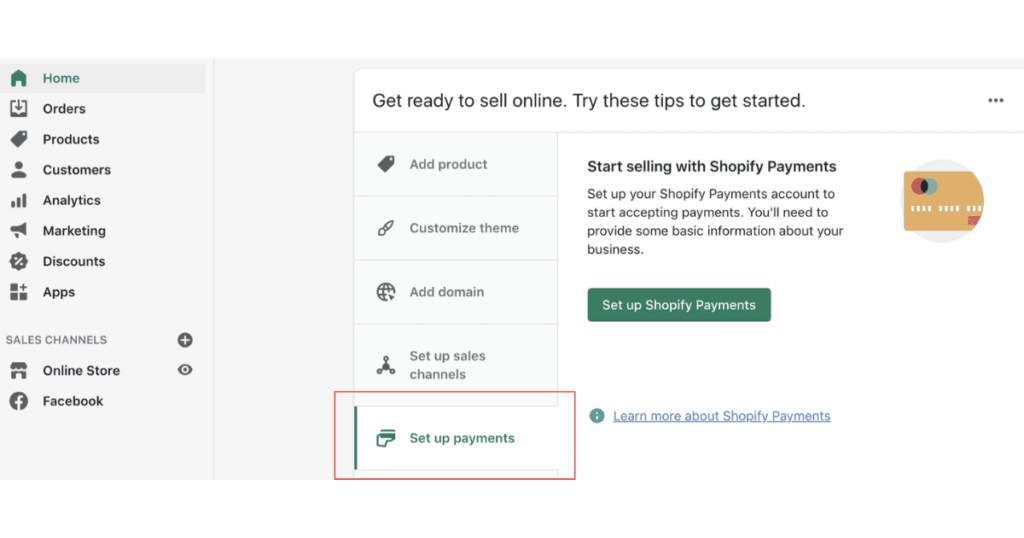
7.1 Enable Multiple Payment Gateways
Give clients a lot of ways to pay so that they may do so easily. Shopify supports major payment providers like PayPal, Stripe, Apple Pay, and all major credit and debit cards, making transactions seamless for your customers. Pick the ones that your target audience uses the most, and make sure the checkout procedure is simple and safe.
7.2 Set Up Shipping Methods
Choose how you will manage delivery. You can give:
- Flat-Rate Shipping: Flat-rate shipping means that the cost is the same no matter how big the order is. It’s easy to understand and plan for.
- Free Shipping: Free shipping is appealing to customers and a wonderful way to get more sales. Consider including shipping costs within your product prices to simplify checkout and improve the overall customer experience.
- Real-Time Carrier Rates: Show the precise rates from USPS, UPS, or FedEx based on where the customer is.
7.3 Define Shipping Zones
Choose where you will ship: within the country, to other countries, or both. Make sure each area has clear rates and rules. If you’re launching an online clothes store, it’s best to keep your zones small at first so you can keep prices down.
7.4 Configure Taxes
In your Shopify settings, you may set up automatic tax computations based on where your store is and where your customers are going. Shopify makes it easier to follow the rules when it comes to taxes, but you should still check your local tax laws or talk to a tax expert if you need to.
7.5 Set Clear Delivery Timelines
Clearly communicate estimated delivery times on product pages and during checkout to set customer expectations and build trust. Setting clear expectations develops trust and makes customers happier, whether you use print-on-demand or do the fulfillment yourself.
Offering payment and delivery choices that are transparent, flexible, and dependable makes your store look more professional and nice to customers. These are two things that anyone who wants to start their own clothing brand online should know.
Also Read About : How Much Does Shopify Website Development Cost?
Step 8: Optimize Your Store for SEO
Search engine optimization (SEO) boosts your store’s visibility in search results, driving more organic traffic and attracting potential customers without paid ads. Strong SEO is an essential if you really want to start an online clothing store. Here’s how to do it:
8.1 Use Relevant Keywords Naturally
Include keywords like “start a clothing brand,” “how to start a clothing business,” and “custom clothing brand” in your page titles, meta descriptions, and headings to improve search rankings and attract the right audience. Make sure they sound natural and not forced.
8.2 Write Engaging Meta Titles and Descriptions
Each page on your website should have a unique meta title and meta description to improve SEO and help search engines understand your content. These show up in search engine results and affect how many people click on them. Like this: Title: “Start Your Clothing Brand Today with Organic Streetwear for Men” Find custom-made streetwear that is good for the environment. Great for people who want to show off their style and support eco-friendly fashion.
8.3 Optimize Product Pages
Use descriptive alt text for photographs, list the size and substance of the product, and use bullet points or subheadings to arrange the content. These procedures make it easier to read and help with SEO.
8.4 Create Essential Static Pages
Pages like “About Us,” “FAQ,” “Shipping & Returns,” and “Contact” help people trust you and are commonly indexed by search engines. Use them to carefully add your keywords. For instance, tell your tale on how to establish your clothes brand.
8.5 Improve URL Structure
Make sure they are clean and have a lot of keywords.
www.xyz.com/collections/women-tshirts is better than www.xyz.com/page?id=567.
8.6 Install SEO Apps (Optional)
Use tools from the Shopify App Store, such Plug In SEO or SEO Manager, to automate audits and make your on-page SEO better.
You have a better chance of being found by clients who are actively looking for clothing companies if you optimize for search engines early on. This is especially true for people who want to learn how to create an online clothing business or purchase from new, distinctive labels.
Also Read the Guide : How can hiring Shopify SEO experts help with increased sales?
Step 9: Launch and Market Your Store
Create an online clothes store is a big deal, but it’s only the first step. You need to market your clothes business in a smart way and build up momentum from the start if you want it to be successful. Here’s how to give your launch the best chance for success:
9.1 Announce Your Launch Loud and Clear
Before you debut, use social media sites like Instagram, TikTok, and Facebook to get people excited about your company. To get people excited, share behind-the-scenes content, sneak previews of your designs, and the story of your company. When your store opens, tell everyone about it through all of your platforms and email newsletters. This lets you get in touch with your community right away and get people to visit your site.
9.2 Collaborate for Exposure
Work with other small firms, producers, or bloggers in your niche to get more exposure. Cross-promotions and freebies are wonderful ways to reach new people, especially if you want to start a clothing brand from scratch and require free exposure.
9.3 Run Paid Ads Strategically
Spend money on ads that are aimed at specific people on sites like Instagram, Facebook, or Pinterest. Fashion is a visual business, therefore pay attention to the pictures. Use advertising to show off your best-selling items, start sales, or get people to visit certain product groups.
9.4 Leverage Influencer Marketing
Use influencer marketing to get in touch with micro- and macro-influencers who share your brand’s style. To get your items or services highlighted in their material, offer them for free or for a fee. Real recommendations from influencers can quickly make you look more trustworthy, especially when you’re just starting ecommerce clothes store.
9.5 Create Launch Offers
Use limited-time discounts, free delivery, or exclusive product drops to make people feel like they need to act quickly. These deals encourage people to buy and help turn your first visitors into loyal customers.
9.6 Track and Adjust
Regularly track your store’s performance and make necessary adjustments to optimize results. Utilize Shopify’s analytics tools along with social media insights to guide your decisions. To gain better outcomes over time, change your messaging, creativity, or audience targeting according on how well they work.
Launching and promoting your store with intention will give your brand the visibility it needs. Whether you’re trying to create a clothing website or open a clothing boutique, these launch strategies will help you hit the ground running.
Step 10: Monitor Performance and Optimize
You still have work to do after your online store is up and running. You need to keep an eye on how your store is doing and make changes based on the data if you want your clothes brand to develop and do well. To expand your success, continual optimization is essential.
10.1 Track Key Metrics with Shopify Analytics
You can keep an eye on important metrics like total sales, traffic sources, top-selling products, average order value, and customer behavior with Shopify’s built-in analytics dashboard. These pieces of information assist you figure out what’s working and what’s not.
10.2 Use Heatmaps and Session Recordings (Optional)
You can use tools like Hotjar or Lucky Orange to see how people use your business. You can see where they click, how far they scroll, and where they leave, which is important for making your store’s layout and user experience better.
10.3 Collect Customer Feedback
Ask customers to write reviews or fill out surveys after they buy anything. Their feedback is incredibly valuable and can provide priceless insights. Use them to make your products better, change the size, or make delivery easier. If you want to run a successful online clothes store for a long time, you need to listen to your clients.
10.4 Optimize Inventory Management
Improve your inventory management by checking it on a regular basis. Quickly restock things that sell well and get rid of items that don’t sell well. Use Shopify apps to create reorder points or notifications for low stock so you don’t miss out on sales.
10.5 Refine Your Marketing Strategy
Change your email campaigns, ad creatives, and social media posts based on how well they are doing. Try out different deals, send emails to people who left their carts empty, and set up loyalty programs to persuade people to buy from you again.
10.6 Stay Updated with Trends and Tech
Fashion and eCommerce change quickly. Stay current with emerging fashion trends, evolving shopping behaviors, and the latest in digital marketing strategies. As you build your online custom clothes brand, you need to keep changing your brand so that it stays relevant and competitive.
You don’t just check and improve once; you do it all the time. If you stay proactive and focused on data, you’ll not only keep your brand going, but you’ll also keep becoming better, growing, and succeeding in the ever-changing world of start online clothing business.
Warming Up Your Audience
Fashion is a fast-paced, creative field with a lot of chances, especially online. You know that having outstanding designs isn’t the only thing that will help you succeed if you’ve already made the brave step of start your own online clothing brand or are just thinking about it. Every step is important, whether you’re learning how to make a website for your clothes business, figuring out how to make things, or trying to get your first customers.
Don’t worry, though; start clothes brand from scratch isn’t as hard as it appears. You can make your idea into a successful, money-making brand if you have the necessary tools, information, and plans.
How Krishang Technolab Can Help You Start and Grow Your Online Clothing Brand
To start a successful online clothing brand, you need more than just good taste. You also need smart technology, a website that is easy to use, and solid ongoing support. That’s where Krishang Technolab comes in. Whether you’re just getting started or looking to scale, you can hire a Shopify developer from our expert team to build a custom, high-performing store that brings your fashion brand to life and keeps it growing.
Krishang Technolab offers customized Shopify development services and eCommerce solutions to assist fashion entrepreneurs like you succeed, whether you’re just learning how to establish your own online clothes company or you’re ready to grow your eCommerce store.
Here’s how we can support your journey:
- Custom Shopify Store DevelopmentWe help you make a clothes website that looks good, loads quickly, and is set up to make sales. Our experts make sure that your store looks and operates great, from one-of-a-kind layouts to being mobile-friendly.
- Theme Customization & UI/UX OptimizationDo you already have a theme in mind? We make it fit your brand, make it easier to navigate, and make the customer journey better, which is very important for turning visitors into purchases.
- Shopify App IntegrationDo you want to add reviews, upsells, or marketing automation for your products? We set up and connect the best Shopify apps to help your business grow and work better.
- Performance & SEO OptimizationWe make sure your store looks good and works well on mobile devices and search engines. This makes it simpler for people to see you shoulder to shoulder with other stores when they search for terms like “start a clothing brand” or “how to start a clothing business.”
- Ongoing Support & MaintenanceOur team offers long-term technical assistance, so you can focus on establishing your brand and designing your next collection. We fix bugs and make upgrades.
From Idea to Reality: Start Your Clothing Brand on Shopify
Start clothing line on Shopify is a fascinating adventure that includes everything from coming up with a brand name to opening and growing your store. If you have the correct attitude, resources, and plan, you may make your fashion dream a successful internet business.
This is the time you’ve been waiting for to start. You may start an online clothes store now with confidence. Just remember that consistency, innovation, and being true to your brand are the keys to success.
Your dream clothing brand starts now and takes the first step!
